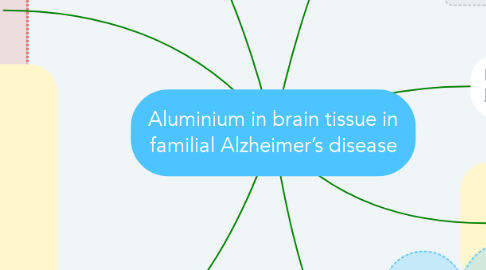
1. Familial Alzheimer's disease (fAD)
1.1. significant history of aluminium and AD
1.2. earlier age of onset than non-familial AD
1.3. recent reports
1.3.1. Aluminium contributes towards AD
2. Aluminium in brain tissue
2.1. Aluminium is present in human brain tissue
2.2. recent study
2.2.1. 60 human brains
2.2.2. median = 1.02 g/g dry weight tissue
2.3. Aluminium is neurotoxic
3. Experiment
3.1. Materials
3.1.1. 12 cases of autopsy-confirmed familial Alzheimer’s disease
3.1.1.1. 7 female,
3.1.1.2. 5 male
3.1.1.3. 42-86 years old
3.1.2. 12 samples per participant
3.1.2.1. 1 sample = 0.3g wet weight and dried to a constant weight at 37 ◦C
3.2. measured by transversely-heated graphite furnace atomic absorption spectrometry (TH GFAAS)
3.3. Results
3.3.1. Al found in all 144 tissues
3.3.1.1. concentration ranged from 0.01 to 35.65 g/g dry wt.
3.3.2. cca 40% of tissues (57/144)
3.3.2.1. pathologically-concerning (≥2.00 g/g dry wt.)
3.3.3. 58%
3.3.3.1. pathologically-significant (≥3.00 g/g dry wt.)
3.3.4. 11 of 12 brains
3.3.4.1. at least 1 pathologically-significant content of aluminium tissue
3.3.5. 9 of 12
3.3.5.1. at least 1 tissue with ≥5.00 g/g dry wt
3.3.6. 5 of 12
3.3.6.1. at least 1 tissue with ≥10.00 g/g dry wt
4. link to article: https://www.sciencedirect.com/science/article/pii/S0946672X17308763
5. About article
5.1. Keywords
5.1.1. Human exposure to aluminium
5.1.2. Human brain tissue
5.1.3. Familial Alzheimer’s disease
5.1.4. Transversely heated graphite furnace atomic absorption spectrometry
5.1.5. Aluminium-selective fluorescence microscopy
5.2. Received 21 November 2016 Accepted 7 December 2016
5.3. Authors
5.3.1. Ambreen Mirzaa
5.3.2. Andrew King b,c
5.3.3. Claire Troakes c
5.3.4. Christopher Exley
6. Discussion
6.1. confirmed aluminium’s presence in each of the familial AD brains investigated
6.2. aluminium content was extremely high
7. Conclusion
7.1. concentrations of aluminium found in these familial AD brains are:
7.1.1. unlikely to be benign
7.1.2. highly likely to have contributed to the onset and aggressive nature of any ongoing AD in these individuals.

